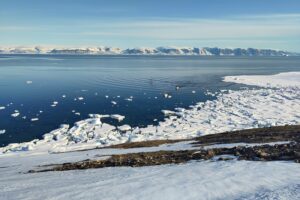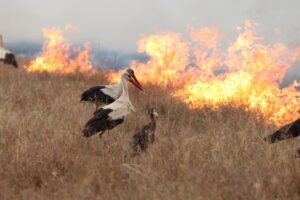A new Greenpeace International report, Toxic Skies: How Agribusiness is Choking the Amazon, reveals how fires linked to industrial agriculture are turning the forest’s air toxic during the dry season. The findings are a stark warning that the Amazon’s crisis is not only about trees. It is about the air millions of people breathe, and the health of our shared planet.

When the sun rises over Porto Velho, on the edge of the Brazilian Amazon, it does not pierce through the mist. It struggles through the smoke. For months each year, the air fills with the haze of fires deliberately set to clear forests for cattle or to renew pasturelands. What was once the world’s greenest ecosystem often breathes air contaminated with higher levels of toxic particles than Beijing, São Paulo or Santiago, according to the report.
What the study found
Researchers monitored air quality in two Amazonian cities, Porto Velho (Rondônia) and Lábrea (Amazonas), combining satellite and ground-based data. The results are alarming:
- During the record-breaking fire season of 2024, levels of fine particulate matter (PM2.5) exceeded WHO daily health guidelines by more than 20 times.
- Even in 2025, a year with far fewer fires, the air still exceeded the guidelines by over six times.
- Between 2019 and 2024, the annual average pollution in Porto Velho was higher than in major global megacities, largely driven by sharp increases in PM2.5 levels during the fire season.
- Around 75% of burned areas around Porto Velho in 2024 are used as pasture for cattle production, showing that most fires are linked to grazing land use.
- More than half of the total burned area in 2024 in the Amazon biome falls within a 360km radius around the facilities of Brazil’s largest meatpacker, JBS. Meatpackers such as JBS do not effectively prohibit and monitor the deliberate use of fire in their supply chains – leaving meatpackers exposed to the risk of indirect or direct supply chain links, including through maintaining business relations, with farms in burned areas.
This is not a natural disaster. It is a business model that profits from destruction and public suffering.
Breathing in the crisis

The Amazon’s fires are not acts of nature. They are deliberately lit to clear forest or renew pastures for cattle. And, behind every statistic are human stories. Hilda Barabadá Karitiana, from the Karitiana Indigenous Territory near Porto Velho, describes how her community lives with the smoke:
During the dry season, the air becomes thick with smoke. Even when the fire is far away, we feel it. Sore throats, constant coughing, and irritated eyes. It affects everyone.– Hilda Barabadá Karitiana
For people like Hilda, the smoke is not just a seasonal nuisance. It is a public health emergency. Exposure to high levels of PM2.5 causes respiratory infections, heart disease and asthma, especially among children and older adults. The air itself has become an agent of crisis.
Debunking Myths
✘ Fires in the Amazon region occur naturally and are beneficial for the ecosystem.
 Fires in the Amazon region are caused by human activity and are highly destructive to the rainforest ecosystem.
Fires in the Amazon region are caused by human activity and are highly destructive to the rainforest ecosystem.
✘ Fires in the Amazon happen because of logging.
 Vast areas of the Amazon biome are set on fire to make way for cattle ranching.
Vast areas of the Amazon biome are set on fire to make way for cattle ranching.
A turning point before COP30
This year’s COP30, hosted in Belém, on the edge of the Amazon, will be the first UN Climate Summit held inside a tropical forest. It is an opportunity to put Amazonian voices and air quality at the centre of global climate negotiations and to demand that governments and corporations act.
Chief Zé Bajaga, from the Caititu Indigenous Territory, says:
Here in the Amazon, we face invasion, fires and pollution from companies that profit while our land burns. Those who destroy for money must be held accountable.– Chief Zé Bajaga
What needs to happen now

World leaders need to step up and:
- COP30 should deliver an action plan to implement the UNFCCC’s 2030 target to halt and reverse deforestation and forest degradation of the world’s forests. It’s time to turn commitments into action.
- Governments must urgently regulate the agricultural and financial sectors to ensure their alignment with the Paris Agreement, the Global Biodiversity Framework, and the UN Sustainable Development Goals.
- Governments must ensure the transition to truly ecological and just food systems, an end to deforestation, and the reduction of emissions associated with agriculture, including methane.
- World leaders must ensure funding for real solutions to protect and restore forests by providing finance directly accessible to Indigenous Peoples and Local Communities.
The Amazon’s toxic skies are not inevitable. They are the product of political choices and economic greed. As world leaders prepare for COP30, this is the moment to act.
Lis Cunha is a campaigner with Greenpeace International’s Respect the Amazon campaign.
Toxic Skies: The Amazon is now breathing dirtier air than the world’s biggest cities
Climate Change
Guest post: How to steer EVs towards the road of ‘mass adoption’
Electric vehicles (EVs) now account for more than one-in-four car sales around the world, but the next phase is likely to depend on government action – not just technological change.
That is the conclusion of a new report from the Centre for Net Zero, the Rocky Mountain Institute and the University of Oxford’s Environmental Change Institute.
Our report shows that falling battery costs, expanding supply chains and targeted policy will continue to play important roles in shifting EVs into the mass market.
However, these are incremental changes and EV adoption could stall without efforts to ensure they are affordable to buy, to boost charging infrastructure and to integrate them into power grids.
Moreover, emerging tax and regulatory changes could actively discourage the shift to EVs, despite their benefits for carbon dioxide (CO2) emissions, air quality and running costs.
This article sets out the key findings of the new report, including a proposed policy framework that could keep the EV transition on track.
A global tipping point
Technology transformations are rarely linear, as small changes in cost, infrastructure or policy can lead to outsized progress – or equally large reversals.
The adoption of new technologies tends to follow a similar pathway, often described by an “S-curve”. This is divided into distinct phases, from early uptake, with rapid growth from very low levels, through to mass adoption and, ultimately, market saturation.
However, technologies that depend on infrastructure display powerful “path-dependency”, meaning decisions and processes made early within the rollout can lock in rapid growth, but equally, stagnation can also become entrenched, too.
EVs are now moving beyond the early-adopter phase and beginning to enter mass diffusion. There are nearly 60m on the road today, according to the International Energy Agency, up from just 1.2m a decade ago.
Technological shifts of this scale can unfold faster than expected. Early in the last century in the US, for example, millions of horses and mules virtually disappeared from roads in under three decades, as shown in the chart below left.
Yet the pace of these shifts is not fixed and depends on the underlying technology, economics, societal norms and the extent of government support for change. Faster or slower pathways for EV adoption are illustrated in the chart below right.
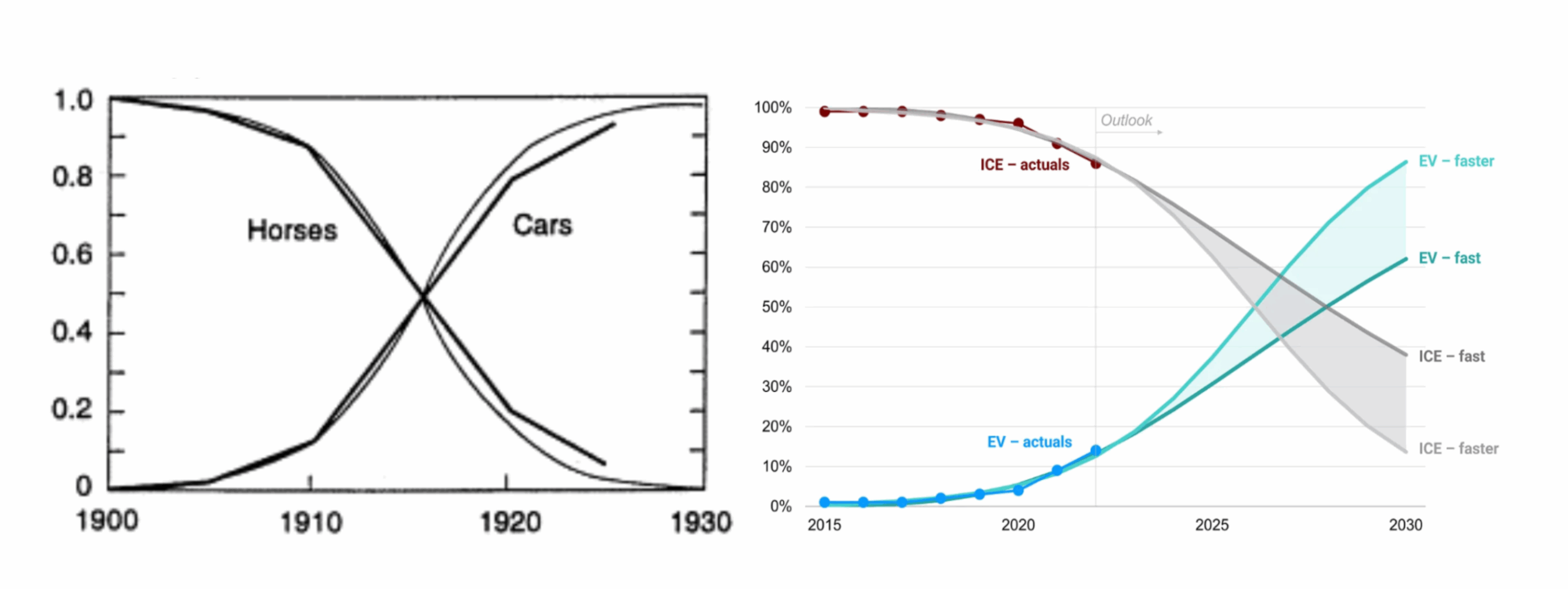
Internal combustion engine (ICE) vehicles did not prevail in becoming the dominant mode of transport through technical superiority alone. They were backed by massive public investment in roads, city planning, zoning and highway expansion funded by fuel taxes.
Meanwhile, they faced few penalties for pollution and externalities, benefitting from implicit subsidies over cleaner alternatives. Standardisation, industrial policy and wartime procurement further entrenched the ICE.
EVs are well-positioned to follow a faster trajectory, as they directly substitute ICE vehicles while being cleaner, cheaper and quieter to run.
Past transitions show that like-for-like replacements – such as black-and-white to colour TVs – tend to diffuse faster than entirely novel products.
Late adopters also benefit from cost reductions and established norms. For example, car ownership took 60 years to diffuse across the US, but just 20 years in parts of Latin America and Japan.
In today’s globalised economy, knowledge, capital and supply chains travel faster still. Our research suggests that the global EV shift could be achieved within decades, not half a century.
Yet without decisive policy, investment and coordination, feedback loops could slow, locking in fossil-fuel dependence.
Our research suggests that further supporting the widespread deployment of EVs hangs on three interlinked actions: supporting adoption; integrating with clean electricity systems; and ensuring sustainability across supply chains and new mobility systems.
Closing the cost gap
EVs have long offered lower running costs than ICE vehicles, but upfront costs – while now cost-competitive in China, parts of Europe and in growing second-hand markets – remain a major barrier to adoption in most regions.
While battery costs have fallen sharply – lithium-ion battery packs fell by 20% in 2024 alone – this has not fully translated into lower retail vehicle prices for consumers.
In China, a 30% fall in battery prices in 2024 translated into a 10% decline in electric SUV prices. However, in Germany, EV retail prices rose slightly in 2024 despite a 20% drop in battery costs.
These discrepancies reflect market structures rather than cost fundamentals. Our report suggests that a competitive EV market, supported by transparent pricing and a strong second-hand sector, can help unlock cost parity in more markets.
Beyond the sale of EVs, government policy around running costs, such as fuel duty, has the potential to disincentivse EV adoption.
For example, New Zealand’s introduction of road-pricing for EVs contributed to a collapse in registrations from nearly 19% of sales in December 2023 to around 4% in January 2024.
EV-specific fees have also been introduced in a number of US states. Last month, the UK also announced a per-mile charge for EVs – but not ICEs – from 2028.
Addressing the loss of fuel-duty revenue as EVs replace ICE vehicles is a headache for any government seeking to electrify mobility.
However, to avoid slowing diffusion, new revenues could be used to build out new charging infrastructure, just as road-building was funded as the ICE vehicle was scaling up.
While subsidies to support upfront costs can help enable EV adoption, the best approach to encouraging uptake is likely to shift once the sector moves into a phase of mass diffusion.
Targeted support, alongside innovative financing models to broaden access, from blended finance to pay-as-you-drive schemes, could play a greater role in ensuring lower-income drivers and second-hand buyers are not left behind.
Mandates as engines of scale
Zero-emission vehicle (ZEV) mandates and ICE phase-out deadlines can reduce costs more effectively than alternatives by guaranteeing market scale, our research finds, reducing uncertainty for automakers and pushing learning rates forward through faster production.
California’s ZEV mandate was one of the first in the 1990s, a policy that has since been adopted by ten other US states and the UK.
China’s NEV quota system has produced the world’s fastest-growing EV market, while, in Norway, clear targets and consistent incentives mean EVs now account for nearly all of new car sales. These “technology-forcing” policies have proved highly effective.
Analyses consistently show that the long-run societal benefits of sales mandates for EVs far outweigh their compliance costs.
For example, the UK’s ZEV mandate has an estimated social net present value of £39bn, according to the government, driven largely by emissions reductions and lower running costs for consumers.
Benefits can also extend beyond national borders. For example, California’s “advanced clean cars II” regulations – adopted by a number of US states and an influence on other countries – have been instrumental in compelling US automakers to develop and commercialise EVs, which can, in turn, trigger innovation and scale to reduce costs worldwide.
Research suggests that, where possible, combining mandates and incentives creates further synergies: mandates alleviate supply-side constraints, making subsidies more effective on the demand side.
Public charging: a critical bottleneck
Public charging is one of the most significant impediments to EV adoption today.
Whereas EVs charged at home are substantially cheaper to run than ICE vehicles, higher public charging costs can erase this benefit – in the UK, this can be up to times the home equivalent.
While most homes in the UK, for example, do have access to off-street parking, there are large swathes of low-income and urban households without access to private driveways. For these households, a lack of cheap public charging has been described as a de facto “pavement tax”, which is disincentivising EV adoption and resulting in an inequitable transition.
Our research shows that a dual-track charging strategy could help resolve the situation. Expanding access to private charging – through cross-pavement cabling, “right-to-charge” legislation for renters and planning mandates for new developments could be combined with strategic investment in public charging, to overcome the “chicken-and-egg” problem for investors uncertain about future EV demand.
Meanwhile, “smart charging” in public settings – where EV demand is matched with cheaper electricity supply – can also help close the affordability gap, by delivering cheap off-peak charging that is already available to those charging at home.
The Centre for Net Zero’s research shows that drivers respond to dynamic pricing outside of the convenience of their homes, which reduces EV running costs below those of petrol cars.
The figure below shows that, while the level of discount being offered had the strongest impact, lower-income areas showed the largest behavioural response, indicating that they may stand to gain the most from a rollout of such incentives.
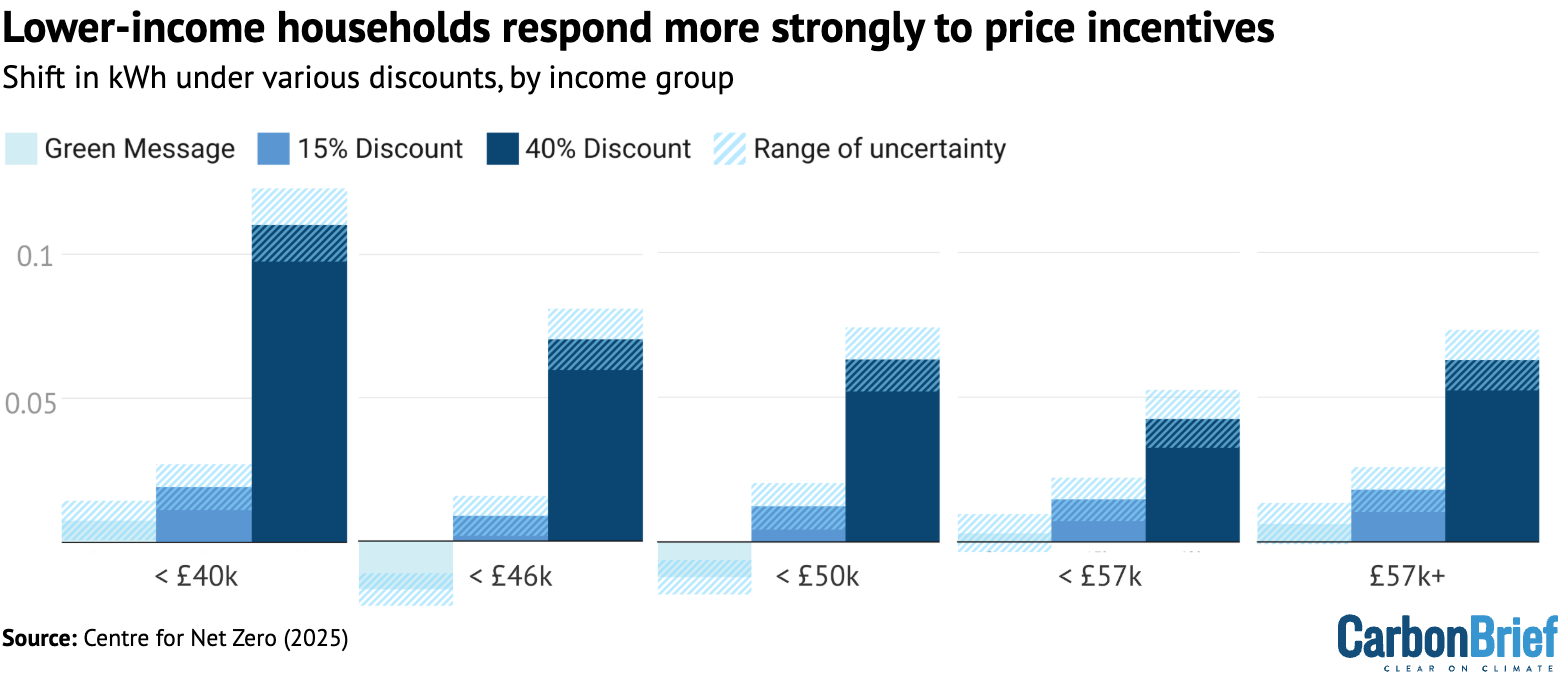
Our research suggests that policymakers could encourage this type of commercial offering by creating electricity markets with strong price signals and mandating that these prices are transparent to consumers.
Integrating with clean electricity grids
Electrification is central to decarbonising the world’s economies, meaning that sufficient capacity on electricity networks is becoming a key focus.
For the rollout of EVs, pressure will be felt most on low-voltage “distribution” networks, where charging is dispersed and tends to follow existing peaks and troughs in domestic demand.
Rather than responding to this challenge by just building out the grid – with the corresponding economic and political implications – making smart charging the norm could help mitigate pressure on the network.
Evidence from the Centre for Net Zero’s trials shows that AI-managed charging can shift EV demand off-peak, reducing residential peak load by 42%, as shown in the chart below.
Additionally, the amount of time when EVs are plugged in but not moving is often substantial, giving networks hours each day in which they can shift charging, targeting periods of low demand or high renewable output.
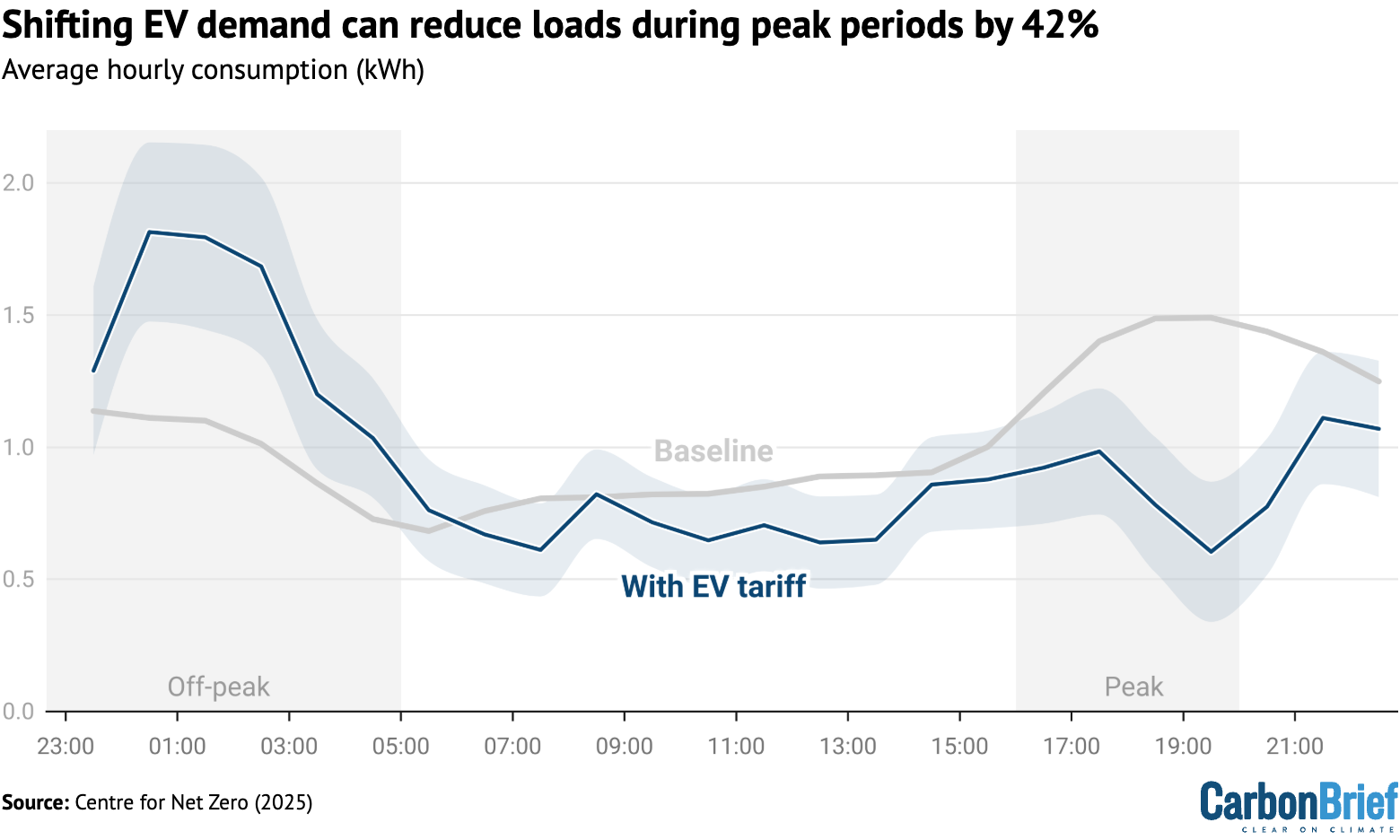
The system value of this flexible charging is significant. In the UK, managed charging could absorb 15 terrawatt hours (TWh) of renewable electricity that would otherwise be curtailed by 2030 – equivalent to Slovenia’s entire annual consumption.
For these benefits to be realised, our research suggests that global policymakers may need to mandate interoperability across vehicles, chargers and platforms, introduce dynamic network charges that reflect local grid stress and support AI-enabled automation.
Bi-directional charging – which allows EVs to export electricity to the grid, becoming decentralised, mobile storage units – remains underexploited. This could allow EVs to contribute to the capacity of the grid, helping with frequency and providing voltage support at both local and system levels.
The nascency of such vehicle-to-grid (V2G) technology means that penetration is currently limited, but there are some markets that are further ahead.
For example, Utrecht is an early leader in real-world V2G deployment in a context of significant grid congestion, while Japan is exploring the use of V2G for system resilience, providing backup power during outages. China is also exploring V2G systems.
Our research shows that if just 25% of vehicles across six major European nations had V2G functionality, then the theoretical total capacity of the connected vehicles would exceed each of those country’s fossil-fuel power fleet.
Mandating V2G readiness at new chargepoints, aligning the value of exports with the value to the system and allowing aggregators to pool capacity from multiple EVs, could all help take V2G from theory to reality.
A sustainable EV system
It is important to note that electrification alone does not guarantee sustainability.
According to Rocky Mountain Institute (RMI) analysis, the total weight of ore needed to electrify the world’s road transport system is around 1,410mtonnes (Mt). This is 40% less than the 2,150Mt of oil extracted every year to fuel a combustion-based system. EVs concentrate resource use upfront, rather than locking in fossil-fuel extraction.
Moreover, several strategies can reduce reliance on virgin minerals, including recycling, new chemistries and improved efficiency.
Recycling, in particular, is progressing rapidly. Some 90% of lithium-ion batteries could now be recycled in some regions, according to RMI research. Under an accelerated scenario, nearly all demand could be met through recycling before 2050.
Finally, while our report focuses largely on EVs, it is important to highlight that they are not a “silver bullet” for decarbonising mobility.
Cities such as Seoul and New York have demonstrated that micromobility, public transport and street redesign can cut congestion, improve health and reduce the number of overall vehicles required.
Better system design reduces mineral demand, lowers network strain and broadens access.
The ‘decision decade’ ahead
Policy decisions made today will determine whether EVs accelerate into exponential growth or stall.
Our research suggests that governments intent on capturing the economic and environmental dividends of electrified mobility are likely to need coherent, cross-cutting policy frameworks that push the market up the steep climb of the EV S-curve.
The post Guest post: How to steer EVs towards the road of ‘mass adoption’ appeared first on Carbon Brief.
Guest post: How to steer EVs towards the road of ‘mass adoption’
Climate Change
“House of cards”: Verra used junk carbon credits to fix Shell’s offsetting scandal
Verra has used nearly a million “hot air” carbon credits to compensate for bogus offsets generated by rice-paddy projects backed by energy giant Shell in China, Climate Home News can reveal.
In a case described as “shocking” and “deeply alarming” by experts, the leading carbon registry replaced 960,000 credits issued for rice-field methane reduction activities that had been found to overstate emissions cuts with an equivalent number of junk credits from other failed Chinese rice projects, its records show.
“It’s frankly unbelievable that Verra considers it appropriate to compensate for hot air credits with other hot air credits,” said Jonathan Crook, policy lead at Carbon Market Watch. “To pretend this is a satisfactory resolution is both absurd and deeply alarming.”
Shell’s links to bogus offsets
Shell is linked to both sets of projects, which Verra ruled as no longer valid in August 2024 after detecting “unprecedented” failures in their implementation. Last year, an investigation by Climate Home News and Dialogue Earth cast serious doubt on whether any emissions-cutting activities were carried out on the ground at all.
In response to those findings, a Shell spokesperson said “the projects in question are not managed or operated by Shell”. But the oil and gas major was closely involved in 10 rice-farming programmes in China as their “authorised representative” and, as Climate Home News reported last year, partly relied on their worthless carbon offsets to market “carbon-neutral” liquefied natural gas (LNG).
Regulatory filings in the US show that Shell, acting as a broker, last year offered to potential buyers the same carbon credits that have now been used as partial compensation for the 10 projects.
For more than a year, Verra failed to replace nearly 2 million worthless credits issued by the 10 projects, after the Chinese developers stopped responding to the registry’s communications with them. Shell abandoned the programmes shortly after Verra ordered that the credits should be compensated.
The credits were primarily used by Shell to offset real greenhouse gas emissions created by its vast fossil fuel operations. Other users of the phantom rice-farming offsets include Chinese state-owned fossil fuel firm PetroChina, Singapore-based DBS Bank and UK energy supplier OVO Energy.
In early October this year, updates to Verra’s registry showed that 960,000 excess credits across the 10 projects had been replaced with an equivalent number of credits drawn from four separate rice-cultivation programmes that were also axed at the same time.
Those original credits had not been voided and technically remained available to the account holder, even though Verra scrapped the underlying programmes and unsuccessfully pursued their representatives for redress. The Chinese company behind the four projects failed to respond to Verra’s requests, leaving it unclear whether the credits will ever be replaced.
Verra’s rules in the spotlight
A Verra spokesperson told Climate Home News that the account holder, “which requested to remain anonymous”, asked the registry to cancel those credits and, subsequently, Verra decided to count them towards the compensation process for the other 10 sham projects.
While Climate Home News could not verify the identity of the account holder in question, Shell declared in public filings that, in 2024, it had marketed those 960,000 credits to potential buyers.
Verra said its rules allow any active credits to be used to cover excess issuance elsewhere, even if those credits themselves need to be replaced. Commenting on this specific case involving the sham rice-farming projects, the spokesperson added: “While the source projects have been rejected and must address their own over-issuance, the credits used here were valid at the time of cancellation.”
Grayson Badgley, a research scientist at climate solutions non-profit CarbonPlan, said this sort of logic might allow Verra to balance its credit ledger but does nothing to help the planet’s atmosphere. “This isn’t just about following the rules – it’s about making sure that the carbon market supports meaningful climate action,” he added.
Compensation orders piling up
Carbon market experts told Climate Home News the case raises serious questions about Verra’s ability to safeguard the integrity of its carbon credits at a critical time when a rapidly growing number of bogus offsets require compensation.
Over 10 million worthless credits produced by the discredited Kariba forest protection megaproject in Zimbabwe, and already used by corporations to back up their green claims, need to be replaced after Verra found the threat to the forest had been exaggerated in the project’s original forecast.
Zimbabwe forest carbon megaproject generated millions of junk credits
In a separate development, Verra is now also seeking the compensation of around 4.5 million credits issued by four vast tree-planting schemes in China. The registry axed the projects last Friday after a year-long review failed to confirm they had been approved by government authorities – a key requirement – and that official documentation had not been falsified.
Shell tied to failed tree-planting schemes
While a Chinese company was in charge of the projects’ implementation, official documents show that, for years, Shell had been directly involved as an “authorised representative”. This role, which the energy giant also held in the rice paddy schemes, gave the firm all the “applicable rights and responsibilities” in relation to the activities.
Shell exited all four tree-planting projects in December 2024, a month after Verra informed the firm it would start the investigation that ultimately led to their cancellation last week.

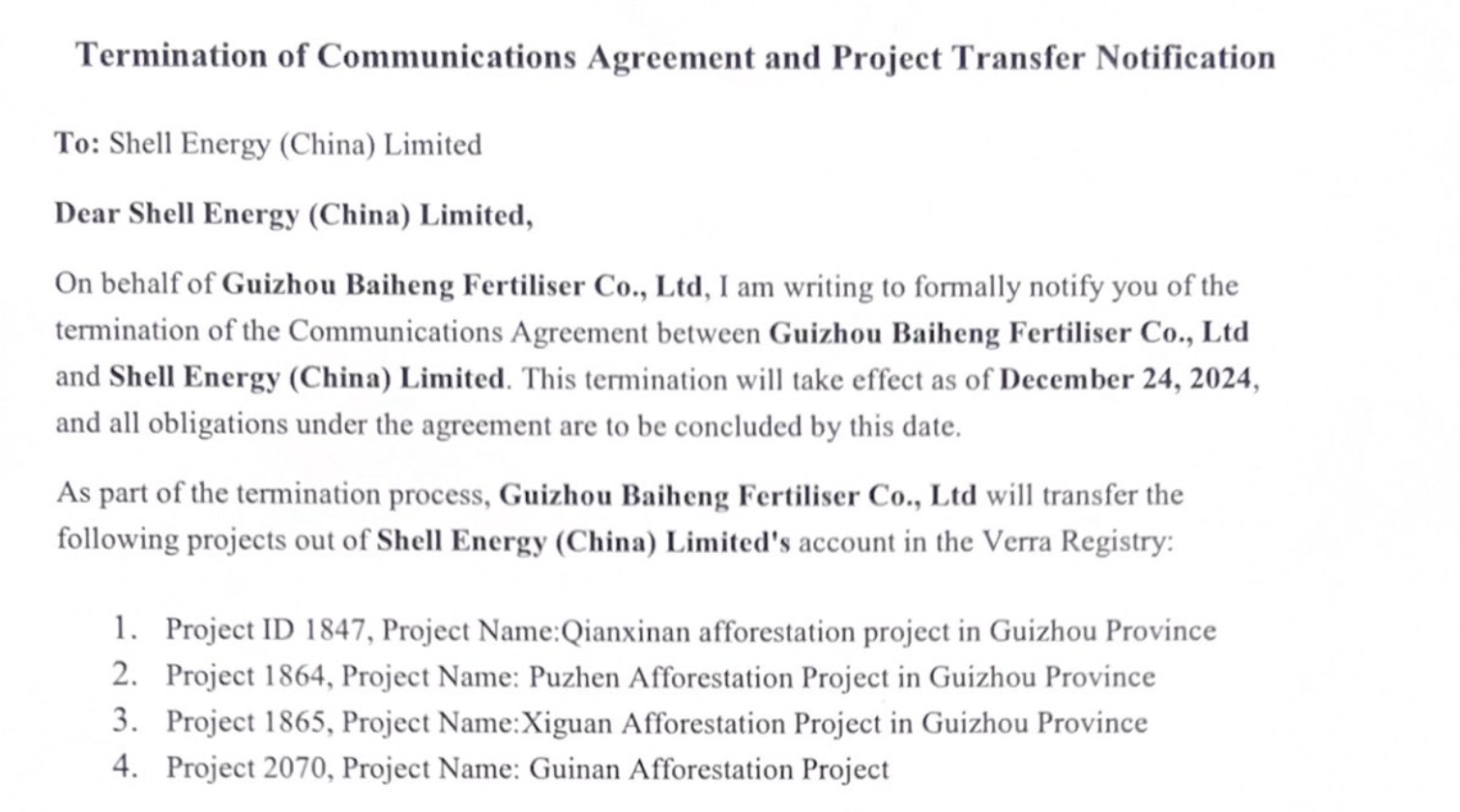


“We purchase and retire a range of Verra-certified credits and were disappointed to learn of the issues Verra identified with these projects and are looking at Verra to replace any credits that were issued under these projects,” a Shell spokesperson told Climate Home News.
For Carbon Market Watch’s Crook, Verra’s unwillingness to deal with “huge loopholes” is not only deeply troubling but also counterproductive as it undermines trust in the registry, while leaving it exposed to future misconduct by unscrupulous actors.
“Rather than take real accountability for this scandal, Verra seems intent on propping up a collapsing house of cards,” he added, referring to the compensation of rice-farming credits.
The post “House of cards”: Verra used junk carbon credits to fix Shell’s offsetting scandal appeared first on Climate Home News.
“House of cards”: Verra used junk carbon credits to fix Shell’s offsetting scandal
Climate Change
Global plastic reduction is the best gift this xmas
The holidays are here again. ‘Tis the season to hang out with (or just tolerate) family and friends, share (and maybe overindulge in) tasty meals, and enjoy festivities (or stay cozy and binge your comfort show). But no matter how you celebrate, the pressure to consume can be extreme.
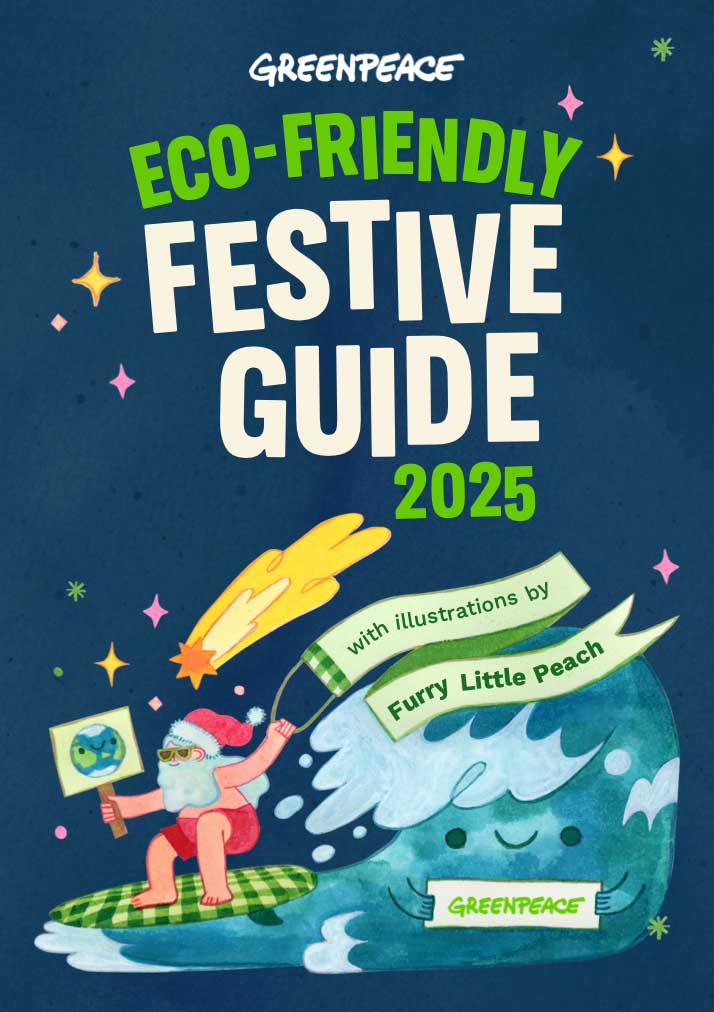
Capitalism’s overconsumption machine can make us think that we need to buy everything during the holidays, but as corporations pump out 430 million tonnes of plastic globally, plastic doesn’t need to get the invite to the big holiday party this year. Dodging certain holiday offerings and embracing some new anti-consumption traditions can be small but mighty acts of resistance against capitalism.
Plastic is everywhere, and at this time of year it’s hiding in plain sight at your holiday gatherings. Plastic packaging is the most obvious major source of waste; however, a closer look at what many decorations and gifts are made of reveals all the other ways plastic creeps into our homes. It is in clothing, bags, bedding, childrens’ toys, holiday figurines, electronics, sports equipment, stuffed animals, cosmetics, kitchenware, furniture, the stir stick in your cocktail or mocktail — the list goes on.
Why does this matter? Because plastic pollutes air, water, nature and our bodies, across its entire lifecycle. And it’s causing widespread and devastating harm. Plastic isn’t only a waste and pollution issue, it has morphed into a grave public health concern. The more plastic the industry produces, the more we’re pressured to consume, and the more pollution people and the planet are exposed to.

5 Ways to reduce plastic waste and pollution during Christmas
The season of giving doesn’t have to be giving plastic disaster. We’re here to share 5 ways to beat those consumption blues.
1. Normalize ‘new-to-you’ over brand new gifts.
It’s never been easier to find pre-loved items in our communities. From thrift shops to antique stores, clothing swaps to flea markets, and numerous online platforms, most gift ideas you have can be found used with a bit of time and resourcefulness. Dodging big corps whenever possible isn’t only satisfying, it’s a win for your wallet and the planet. According to Earth Overshoot Day and its partners, by July 24th, 2025 humanity was using nature about 1.8 times faster than the Earth’s ecosystems are able to regenerate, so reducing demand for new materials is part of our collective consumption reduction equation. If you look at the plastic all around you today, it is set to have more than doubled in the next 25 years.
Any signal we can send to big plastic producers and consumer goods companies that plastic isn’t fantastic, can help incentivize them to choose alternatives, and show governments that we support real solutions to the plastic problem.

2. Choose your containers and cookware with care
It’s a lovely time of year for meals out and coffee dates but because non-toxic, reusable containers are not yet ubiquitous, bringing your own plastic-free containers whenever possible will reduce your plastic exposure and footprint. Plastic-lined coffee cups, “bioplastic” packaging and cutlery, and even take-out containers labeled as reusable, present an opportunity for contaminating our food and our bodies with microplastics and chemicals. Various kitchenware items in our homes also contain plastic. Large plastic spatulas and spoons, sieves and strainers, cutting boards, storage containers, sippy cups, electric kettles, blenders and Teflon or coated pans all can contain or are made from plastic. Scientists have begun to uncover how using these types of items contributes to our ingestion of microplastics and exposure to potentially toxic chemicals. There’s nothing festive about a charcuterie board seasoned with microplastics.
It’s not easy or affordable to do a full kitchen overhaul, but you can start by doing small changes like ditching plastic cutting boards, never heating plastic, and using stainless steel or cast iron instead of coated pots and pans. When hosting, remember reusable is best — ditch the single-use plates, cups, and cutlery and just use what you have on hand. Crowd source dishware when needed, that’s what friends are for.

3. Glitter isn’t glam, your inner sparkle is enough!
Who doesn’t want a little glitz at this time of year? So much of what is extra sparkly and shiny is a combination of plastic and metal, and it’s nothing but a beautiful nightmare. Glitter shows up in craft supplies, gift wrap, decorations, clothing, cosmetics, kids’ toys, costumes, party hats, and snow globes. Plastic glitter and sequins can easily shed into its surroundings, when clothing is being washed or crafts are being cleaned-up, it can shed down the drain, and when combined with paper or other materials, these products ruin recycling potential, sending them to landfill or incineration. And while some may claim to be biodegradable, it’s really not worth the potential pollution risk.

4. Resist the urge to purge
Out with the old and in with the new can be a useful mantra when letting go of negative vibes or questionable habits, but when it comes to “stuff”, we all need to resist the temptation to get the newer, trendier, or upgraded item. We live in an era where we’re being given mixed messages about simplifying our lives and our relationship with material things. We’re told to buy more, but also buy better. Wide leg jeans today, skinny jeans tomorrow. But purging in the name of decluttering isn’t an act for the planet. It can also overburden donation organizations. Unless the purge is paired with a commitment to minimalist living, chances are a lot of that stuff will eventually be replaced, increasing the resource burden. Buying a bunch of new stuff can result in a bunch more plastic produced, so try to ponder before you purge and consider what might be reused, refurbished, remanufactured, revived, refurnished, repurposed, remade, regifted, rotated out, rotated in, rearranged, reimagined, and/or relocated.

5. Cozy up with a petition to change the world.
Trying to dodge plastic can be exhausting. If you’re feeling overwhelmed, you’re not alone. We can only do so much in this broken plastic-obsessed system. Plastic producers and polluters need to be held accountable, and governments need to act faster to protect the health of people and the planet. The plastic crisis is a global problem demanding a global solution. We urgently need global governments to secure a strong UN Global Plastics Treaty that reduces global production and consumption, ends our reliance on problem plastics and chemicals, and accelerates a justice-centred transition to a reuse-based, zero waste future. Ensure your government doesn’t waste this once-in-a-generation opportunity to end the age of plastic. Sign our petition!
-
Climate Change4 months ago
Guest post: Why China is still building new coal – and when it might stop
-
Greenhouse Gases4 months ago
Guest post: Why China is still building new coal – and when it might stop
-
Climate Change2 years ago
Spanish-language misinformation on renewable energy spreads online, report shows
-

 Greenhouse Gases2 years ago
Greenhouse Gases2 years ago嘉宾来稿:满足中国增长的用电需求 光伏加储能“比新建煤电更实惠”
-
Climate Change Videos2 years ago
The toxic gas flares fuelling Nigeria’s climate change – BBC News
-

 Climate Change2 years ago
Climate Change2 years ago嘉宾来稿:满足中国增长的用电需求 光伏加储能“比新建煤电更实惠”
-

 Carbon Footprint2 years ago
Carbon Footprint2 years agoUS SEC’s Climate Disclosure Rules Spur Renewed Interest in Carbon Credits
-
Climate Change2 years ago
Why airlines are perfect targets for anti-greenwashing legal action



